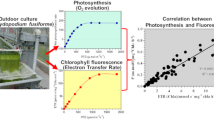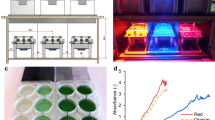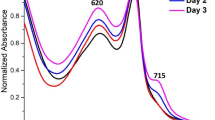Abstract
The photon use efficiencies and maximal rates of photosynthesis in Dunaliella salina (Chlorophyta) cultures acclimated to different light intensities were investigated. Batch cultures were grown to the mid-exponential phase under continuous low-light (LL: 100 μmol photon m-2 s-1) or high-light (HL: 2000 μmol photon m-2 s-1) conditions. Under LL, cells were normally pigmented (deep green) containing ∼500 chlorophyll (Chl) molecules per photosystem II (PSII) unit and ∼250 Chl molecules per photosystem I (PSI). HL-grown cells were yellow-green, contained only 60 Chl per PSII and 100 Chl per PSI and showed signs of chronic photoinhibition, i.e., accumulation of photodamaged PSII reaction centers in the chloroplast thylakoids. In LL-grown cells, photosynthesis saturated at ∼200 μmol photon m-2 s-1 with a rate (Pmax) of ∼100 mmol O2 (mol Chl)-1 s-1. In HL-grown cells, photosynthesis saturated at much higher light intensities, i.e. ∼2500 μmol photon m-2 s-1, and exhibited a three-fold higher Pmax (∼300 mmol O2 (mol Chl)-1 s-1) than the normally pigmented LL-grown cells. Recovery of the HL-grown cells from photoinhibition, occurring prior to a light-harvesting Chl antenna size increase, enhanced Pmax to ∼675 mmol O2 (mol Chl)-1 s-1. Extrapolation of these results to outdoor mass culture conditions suggested that algal strains with small Chl antenna size could exhibit 2–3 times higher productivities than currently achieved with normally pigmented cells.
Similar content being viewed by others
References
Anderson JM (1986) Photoregulation of the composition, function and structure of thylakoid membranes. Annu. Rev. Plant Physiol. 37: 93-136.
Arnon D (1949) Cooper enzymes in isolated chloroplasts. Polyphenol oxidase in Beta vulgaris. Plant Physiol. 24: 1-15.
Avron M, Ben-Hayyim G (1969) Interaction between two photochemical systems in photoreactions of isolated chloroplasts. In: Metzner H (ed.), Progress in Photosynthesis Research, Vol. III. H. Laupp Jr, Tubingen: 1185-1196.
Barber J, Andersson B (1992) Too much of a good thing: light can be bad for photosynthesis. Trends Biochem. Sci. 17: 16-66.
Baroli I, Melis A (1996) Photoinhibition and repair in Dunaliella salinaacclimated to different growth irradiances. Planta 198: 640-646.
Baroli I, Melis A (1998) Photoinhibitory damage is modulated by the rate of photosynthesis and by the photosystem II lightharvesting chlorophyll antenna size. Planta 205: 288-296.
Björkman O, Demmig B (1987) Photon yield of O2 evolution and chlorophyll fluorescence characteristics at 77 K among vascular plants of diverse origins. Planta 170: 489-504.
Björkman O, Ludlow MM (1972) Characterization of the light climate on the floor of a queensland rainforest. Carnegie Institution Yearbook 71: 85-94.
Burlew JS (1953) Algal Culture: from laboratory to pilot plant. Carnegie Institution of Washington, Washington, D.C. Publication Number 600: 235-272.
Chain RK, Arnon DI (1977) Quantum efficiency of photosynthetic energy use. Proc. Natl. Acad. Sci. USA 74: 3377-3381.
Demmig B, Björkman O (1987) Comparison of the effect of excessive light on chlorophyll fluorescence (77 K) and photon yield of O2 evolution in leaves of higher plants. Planta 171: 171-184.
Greenbaum E (1984) Biophotolysis of water: the light saturation curves. Photobiochem. Photobiophys. 8: 323-332.
Herron HA, Mauzerall D (1972) The development of photosynthesis in a greening mutant of Chlorellaand an analysis of the light saturation curve. Plant Physiol. 50: 141-148.
Huner NPA, Öquist G, Sarhan F (1998) Energy balance and acclimation to light and cold. Trends in Plant Science 3: 224-230.
Kim JH, Hemson JA, Melis A (1993) Photosystem II reaction center damage and repair in Dunaliella salina(green alga): Analysis under physiological and irradiance-stress conditions. Plant Physiol. 103: 181-189.
Kirk JTO (1994) Light and Photosynthesis in Aquatic Ecosystems. 2nd Edn. Cambridge University Press, Cambridge, England.
Kok B (1953) Experiments on photosynthesis by Chlorellain flashing light. In: Burley JS (ed.), Algal Culture: From Laboratory to Pilot Plant. Carnegie Institution of Washington, Washington DC: 63-75.
Kok B (1960) Efficiency of photosynthesis. In: Ruhland W (ed.), Encyclopedia of Plant Physiology. Springer Verlag, Berlin: 566-633.
Ley AC, Mauzerall DC (1982) Absolute absorption cross sections for photosystem II and the minimum quantum requirement for photosynthesis in Chlorella vulgaris. Biochim. Biophys. Acta 680: 95-106.
Melis A (1989) Spectroscopic methods in photosynthesis: photosystem stoichiometry and chlorophyll antenna size. Phil. Trans. R. Soc. Lond. B 323: 397-409.
Melis A (1991) Dynamics of photosynthetic membrane composition and function. Biochim. Biophys. Acta (Reviews on Bioenergetics) 1058: 87-106.
Melis A (1996) Excitation energy transfer: Functional and dynamic aspects of Lhc(cab) proteins. In: Ort DR, Yocum CF (eds), Oxygenic Photosynthesis: The Light Reactions. Kluwer Academic Publishers, Dordrecht, The Netherlands: 523-538.
Melis A (1998) Photostasis in plants: mechanisms and regulation. In: Williams TP, Thistle A (eds), Photostasis. Plenum Publishing Corporation, New York, NY: 207-221.
Melis A, Murakami A, Nemson JA, Aizawa K, Ohki K, Jujita Y (1996) Chromatic regulation in Chlamydomonas reinhardtiialters photosystem stoichiometry and improves the quantum efficiency of photosynthesis. Photosynth. Res. 47: 253-265.
Melis A, Neidhardt J, Baroli I, Benemann JR (in press) Maximizing photosynthetic productivity and light utilization in microalgae by minimizing the light-harvesting chlorophyll antenna size of the photosystems. In: Zaborsky OR (ed.), BioHydrogen '97. Proceedings of the International Conference on Biological Hydrogen Production. Waikoloa-Hawaii, Plenum Publishing Corporation, New York, NY.
Myers J (1957) Algal culture. In: Kirk RE, Othmer DE (eds), Encyclopedia of Chemical Technology. Interscience, New York, NY: 649-680.
Naus J, Melis A (1991) Changes of photosystem stoichiometry during cell growth in Dunaliella salinacultures. Plant Cell Physiol. 32: 569-575.
Neale PJ, Melis A (1986) Algal photosynthetic membrane complexes and the photosynthesis-irradiance curve: a comparison of light-adaptation responses in Chlamydomonas reinhardtii. J. Phycol. 22: 531-538.
Neale PJ, Cullen JJ, Lesser MP, Melis A (1993) Physiological bases for detecting and predicting photoinhibition of aquatic photosynthesis by PAR and UV radiation. In: Yamamota HY, Smith CM (eds), Photosynthetic Responses to the Environment. Current Topics in Plant Physiology. American Society of Plant Physiologists Publication Series, Volume 8: 61-77.
Neidhardt J, Benemann JR, Zhang L, Melis A (1998) Photosystem II repair and chloroplast recovery from irradiance stress: relationship between chronic photoinhibition, light-harvesting chlorophyll antenna size and photosynthetic productivity in Dunaliella salina(green algae). Photosynth. Res. 56: 175-184.
Osborne BA, Geider RJ (1987) The minimum photon requirement for photosynthesis. New Phytologist 106: 631-644.
Pick U, Karni L, Avron M (1986) Determination of ion content and ion fluxes in the halotolerant alga Dunaliella salina. Plant Physiol. 81: 92-96.
Powles SB (1984) Photoinhibition of photosynthesis induced by visible light. Annu. Rev. Plant Physiol 35: 15-44.
Powles SB, Critchley C (1980) Effect of light intensity during growth on photoinhibition of intact attached bean leaflets. Plant Physiol. 65: 1181-1187.
Richmond A (1996) Efficient utilization of high irradiance for production of photoautotrophic cell mass: A survey. J. appl. Phycol. 8: 381-387.
Smith BM, Morrissey PJ, Guenther JE, Nemson JA, Harrison MA, Allen JF, Melis A (1990) Response of the photosynthetic apparatus in Dunaliella salina(green algae) to irradiance stress. Plant Physiol. 93: 1433-1440.
Starr RC (1978) The culture collection of algae at the University of Texas at Austin. J. Phycol. 14: 47-100.
Sukenik A, Bennett J, Falkowski PG (1988) Changes in the abundance of individual apoproteins of light harvesting chlorophyll a/b-protein complexes of photosystem I and II with growth irradiance in the marine chlorophyte Dunaliella tertiolecta. Biochim. Biophys. Acta 932: 206-215.
Sun ASK, Sauer K (1971) Pigment systems and electron transport in chloroplasts. Biochim. Biophys. Acta 234: 399-414.
Vasilikiotis C, Melis A (1994) Photosystem II reaction center damage and repair cycle: chloroplast acclimation strategy to irradiance stress. Proc. natl Acad. Sci. USA 91: 7222-7226.
Weaver PF, Lien S, Seibert M (1980) Photobiological production of hydrogen. Solar Energy 24: 3-45.
Author information
Authors and Affiliations
Rights and permissions
About this article
Cite this article
Melis, A., Neidhardt, J. & Benemann, J.R. Dunaliella salina (Chlorophyta) with small chlorophyll antenna sizes exhibit higher photosynthetic productivities and photon use efficiencies than normally pigmented cells. Journal of Applied Phycology 10, 515–525 (1998). https://doi.org/10.1023/A:1008076231267
Issue Date:
DOI: https://doi.org/10.1023/A:1008076231267




